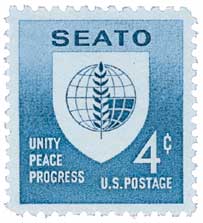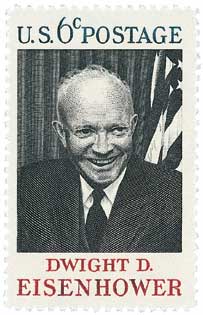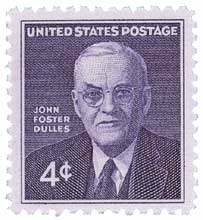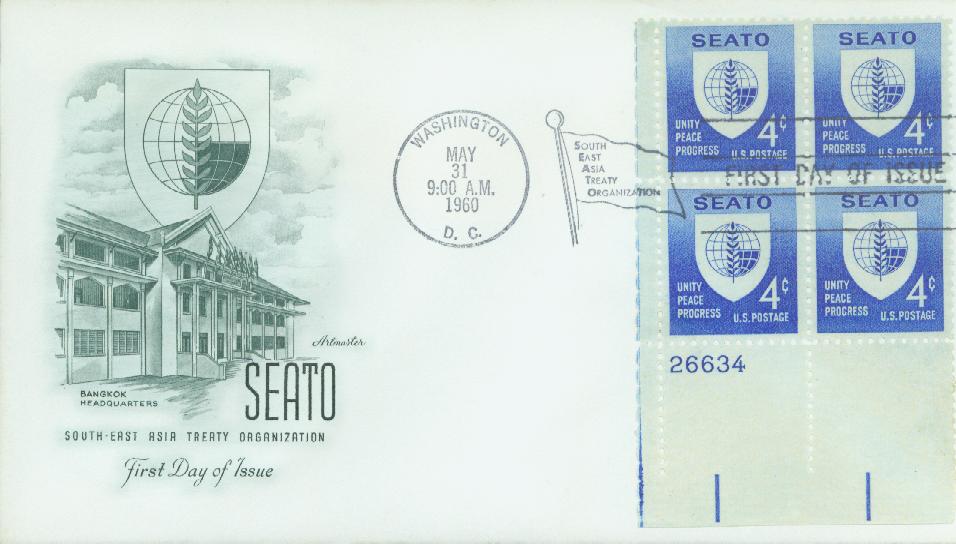
# 1151 FDC - 1960 4c SEATO
Formation Of SEATO

On September 8, 1954, eight nations signed the Southeast Asia Collective Defense Treaty, or Manila Pact, creating the Southeast Asia Treaty Organization (SEATO).
President Dwight D. Eisenhower directed his Secretary of State John Foster Dulles to establish the agreement to combat communism in Vietnam, Laos, Cambodia, and Southeast Asia in general. This was part of the Truman Doctrine established by his predecessor to counter Soviet expansion during the Cold War.

Eisenhower turned to diplomat and soviet expert George D. Kennan to develop the policy and Dulles to push for its creation. Additionally, Eisenhower’s Vice President Richard Nixon encouraged the creation of an Asian equivalent of NATO after visiting Asia in late 1953.
The eight nations (France, Great Britain, Australia, New Zealand, the Philippines, Pakistan, Thailand, and the United States) signed the treaty on September 8, 1954 in Manila, Philippines. The organization’s treaty partners then met in Bangkok, Thailand on February 19, 1955, for their first formal meeting.

Each of these nations pledged to “act to meet the common danger” if one of the other signatories was attacked. Thought it was meant to be similar to the North Atlantic Treaty Organization, it didn’t have as strong a requirement for mutual defense. Instead, SEATO provided for consultations before military action would take place. Some saw this as a weakness, though the U.S. later used SEATO as its legal basis for joining the Vietnam War.
SEATO also provided for joint military training and member states worked together to improve social and economic issues. SEATO’s Committee of Information, Culture, Education, and Labor Activities carried these out. They also created the Asian Institute of Technology to train engineers in Thailand, the Teacher Development Center in Bangkok, the Thai Military Technical Training School, and SEATO’s Skilled Labor Project.
Formation Of SEATO

On September 8, 1954, eight nations signed the Southeast Asia Collective Defense Treaty, or Manila Pact, creating the Southeast Asia Treaty Organization (SEATO).
President Dwight D. Eisenhower directed his Secretary of State John Foster Dulles to establish the agreement to combat communism in Vietnam, Laos, Cambodia, and Southeast Asia in general. This was part of the Truman Doctrine established by his predecessor to counter Soviet expansion during the Cold War.

Eisenhower turned to diplomat and soviet expert George D. Kennan to develop the policy and Dulles to push for its creation. Additionally, Eisenhower’s Vice President Richard Nixon encouraged the creation of an Asian equivalent of NATO after visiting Asia in late 1953.
The eight nations (France, Great Britain, Australia, New Zealand, the Philippines, Pakistan, Thailand, and the United States) signed the treaty on September 8, 1954 in Manila, Philippines. The organization’s treaty partners then met in Bangkok, Thailand on February 19, 1955, for their first formal meeting.

Each of these nations pledged to “act to meet the common danger” if one of the other signatories was attacked. Thought it was meant to be similar to the North Atlantic Treaty Organization, it didn’t have as strong a requirement for mutual defense. Instead, SEATO provided for consultations before military action would take place. Some saw this as a weakness, though the U.S. later used SEATO as its legal basis for joining the Vietnam War.
SEATO also provided for joint military training and member states worked together to improve social and economic issues. SEATO’s Committee of Information, Culture, Education, and Labor Activities carried these out. They also created the Asian Institute of Technology to train engineers in Thailand, the Teacher Development Center in Bangkok, the Thai Military Technical Training School, and SEATO’s Skilled Labor Project.







